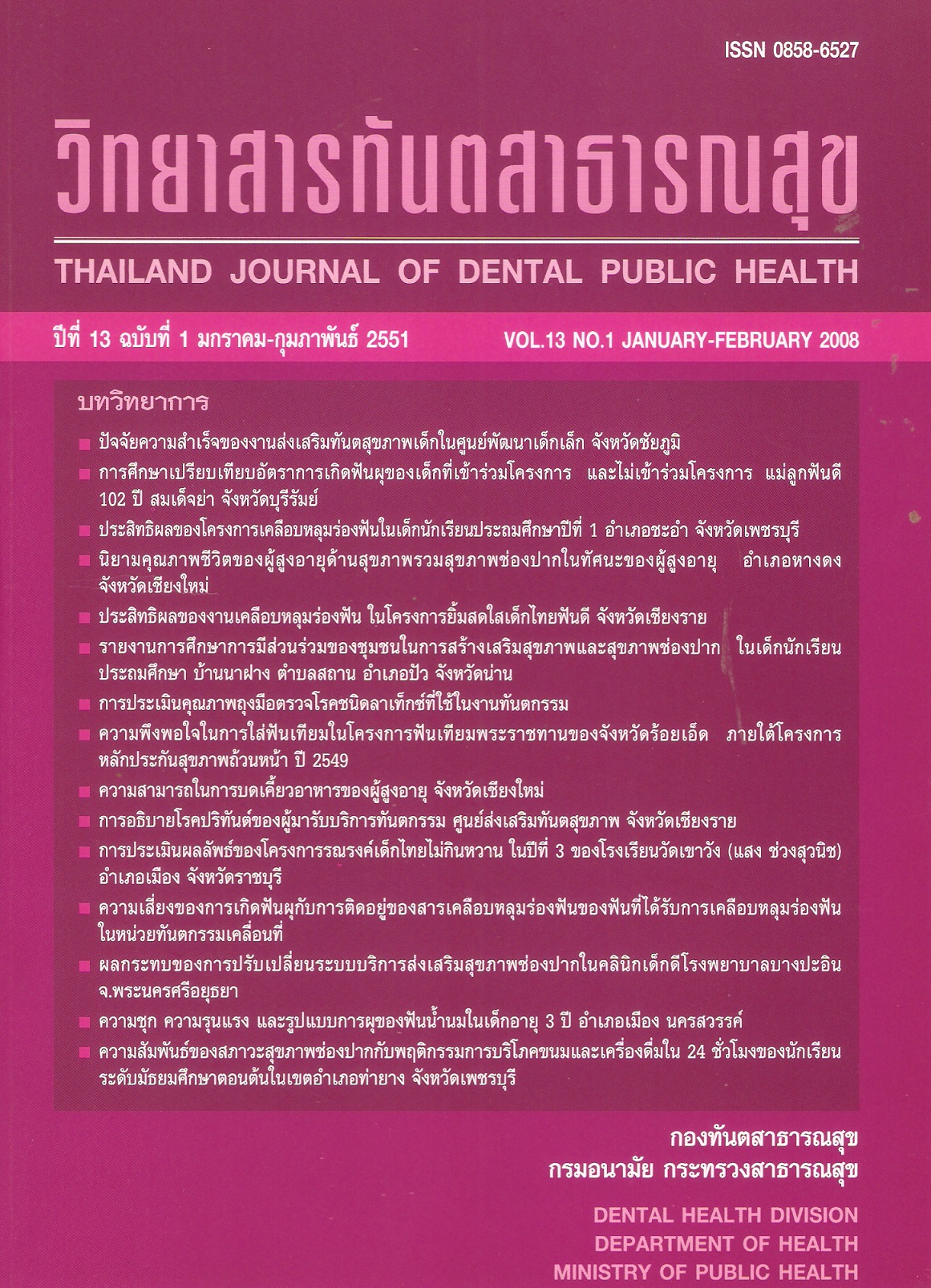Prevalence, severity and dental caries pattern among 3-year-old children in Muang District, Nakhonsawan.
Main Article Content
Abstract
The purpose of this cross sectional study was to determine the prevalence, severity and primary dental caries pattern in 3-year-old children in Muang District, Nakhonsawan. A total of 546 children were examined by using WHO criteria. Descriptive statistics and chi square were used to analyze the data. The prevalence of caries, severe early childhood caries (dmft 24), molar-proximal caries and retained root were 60.8, 34.6, 12.1 and 15.4% respectively. Mean dmft and dmfs were 3.00+3.63 and 6.82–11.32. Children with severe early childhood caries were nine times more likely to develop posterior proximal caries (odds ratio = 8.82, 95%CI = 3.89 - 20.01). Upper central incisors were most affected by caries (49%) especially on the mesial surfaces (31.5%). The most affected occlusal surfaces were lower second right molars effective prevention programs are needed and should be implemented before the age of 3.
Downloads
Article Details
References
2. สํานักงานสาธารณสุขจังหวัดนครสวรรค์ สรุปผลการสํารวจสภาวะทันตสุขภาพตาม กลุ่มอายุ จังหวัดนครสวรรค์ 2547-2549. เอกสารอัดสําเนา
3. AAPD. Definition of Early Childhood Caries (ECC). [online], 2007. Available from: URL: http://www.aapd.org/media/ Policies_Guidelines/D_ECC.pdf
4. AAPD. Policy on Early Childhood Caries (ECC): Classifications, Consequences, and Preventive strategies. [online], 2007. Available from: URL: http://www.aapd. org/media/Policies_Guidelines/P_ECC Classifications.pdf
5. สํานักงานสาธารณสุขจังหวัดน่าน. รายงานผลการสํารวจสภาวะทันตสุขภาพกลุ่มอายุ 3 ปี จังหวัดน่าน 2549. เอกสารอัดสําเนา
6. Johnsen DV. Comparison of primary and permanent teeth. In Avery JK, editor. Oral Development and Histology 2nd ed. New York Thieme Medical Publishers Inc.;1994. P.282-296
7. Randall RC, Vrijhoef MMA, Wilson NHF. Efficacy of preformed metal crowns vs amalgam restorations in primary molars: A systemic review. J Am Dent Assoc2000; 131:337-43
8. Miyamoto W, Chung CS, Yee PK. Effect of premature loss of deciduous canines and molars on malocclusion of the permanent dentition. J Dent Res. 1976 Jul-Aug;55(4):584-90
9. Lin YT, Chang LC. Space changes after premature loss of the mandibular primary first molar: a longitudinal study. J Clin Pediatr Dent. 1998 Summer;22(4):311-6
10. Cuoghi OA, Bertoz FA, de Mendonca MR, Santos EC. Loss of space and dental arch length after the loss of the lower first primary molar: a longitudinal study. J Clin Pediatr Dent. 1998 Winter;22(2):117-20.
11. Tinanoff N and DM O'Sullivan. Early Childhood caries : Overview and recent findings. American Academy of Pediatric Dentistry 1997;19:12-15
12. Milnes AR. Description and epidemiology of nursing caries. J Public Health Dent 1996;56:38-50
13. Millet D, Welbury R. Orthodontics and paediatric dentistry. Edinburgh, Churchill Livingstone; 2000. P.85-89
14. Marino RV, Bomze K, Scholl TO, Anhalt H. Nursing bottle caries: characteristics of children at risk. Clin Pediatr 1989; Mar: 28(3): 129-31
15. Hallett KB, O'Rourke PK. Pattern and severity of early childhood caries. Community Dent Oral Epidemiol 2006; 34:25-35
16. nawouaumossu Isuwunuhanassa ประชารักษ์, รายงานสถานการณ์ศูนย์พัฒนา เด็กเล็กและโรงเรียนอนุบาลในเขตอําเภอเมือง unsaassaí 2550.
17. Greenwell AL and Johnson D. Longitudinal evaluation of caries pattern from the primary to the mixed dentition. Pediatr Dent 1990;12:278-282
18. Vanderas AP, Gizani S and Papagiannoulis L. Progression of proximal caries in children with different caries indices: a 4-year radiographic study. Eur Arch Paediatr Dent. 2006 Sep;7(3):148-52
19. Grindefjord M, Dahllof G, Modeer T. Caries development in children from 2.5 to 3.5 years of age: A longitudinal study. Caries Res 1995;29:449-54
20. Peretz B, Ram D, Azo E, Efrat Y. Preschool caries as an indicator of future caries: a longitudinal study. Pediatr Dent 2003;25:114-8
21. Li Y and Wang W. Predicting caries in permanent teeth from caries in primary teeth: An eight-year Cohort study. J Dent res 2002:81:561-566
22. O'Sullivan DM and Tinanoff N. The association of early dental caries patterns with caries incidence in preschool children. J Public Health Dent. 1996 Spring;56(2):81-3
23. Zero D, Fontana M, Lennon AM. Clinical applications and outcome of using indicators of risk in caries management. J Dent Educ 2001;65:1126-32
24. O'Sullivan DM and Tinanoff N. Maxillary anterior caries associated with increased caries risk in other primary teeth. J Dent Res. 1993 Dec;72(12):1577-80.


